"On what can we now place our hopes of solving the many riddles which still exist as to the origin and composition of cosmic rays?" -Victor Francis Hess
We've come a tremendously long way in our understanding of the Universe, but there are plenty of mysteries still to be revealed. Way back in the late 1800s, we noticed that there was an unaccounted-for excess in the amount of ionization in the upper atmosphere, something that our Sun and Earth, by themselves, couldn't explain.
Victor Francis Hess -- the originator of the quote atop -- decided to go see for himself, and conducted a series of balloon-borne experiments to get to the bottom of the puzzle.
100 years ago, Hess became the discoverer of cosmic rays, or very high energy particles whose origin comes from beyond our own Solar System. Since that time, many advances in understanding the origin and production of these particles has occurred, as well as the measurement of just what's flying around through interstellar space.
Most of the high-energy particles flying around are protons, the most common atomic nucleus in the Universe. These cosmic rays have a huge energy range, ranging from non-relativistic speeds all the way up to around a whopping 1020 electron-Volts, or about a factor of 10,000,000 greater than the LHC -- even at maximum energy after the upgrade-in-progress -- will ever achieve. There are also much smaller numbers of cosmic-ray electrons, followed by trace amounts of cosmic-ray antimatter, including positrons and anti-protons.
Where do they come from? That's part of the fun!
There are tons of astrophysical sources for cosmic rays, both in our galaxy and beyond. These range from young stars surrounded by dust and debris, white dwarfs and neutron stars (including pulsars), as well as black holes, including stellar-mass-size ones, supermassive ones, and everywhere in between.
Some cosmic rays show a clear origin from point sources, such as the pulsar at the center of the crab nebula, below.
That's the cosmic ray side of things.
At the same time, there's another puzzle in the Universe: the dark matter puzzle.
Since the latest results from PLANCK came in, we've had our picture of the Universe confirmed once again: there is, in fact, some type of dark, non-standard-model mass out there, in about five times the abundance of all the normal matter in the Universe combined.
Now, dark matter -- in most models -- happens to be its own antiparticle, which means if you have a collision of a dark matter particle with itself, you're going to get a bunch of energy out. That can come in any form that the mass of dark matter allows: photons, electron/positron pairs, proton/anti-proton pairs, etc. Although experiments have placed constraints on what the masses and cross-section of dark matter is allowed to be, we have yet to have a definitive positive particle detection of dark matter.
It's important to point out, at this point, that dark matter could have a mass anywhere from a few micro-electron-Volts all the way up to, in principle, 1024 electron-Volts. We're only focused on the GeV-to-TeV mass range because that's what we're most capable of detecting!
Well, enter the latest attempt at indirect detection of dark matter, the Alpha Magnetic Spectrometer.
 Image credit: Ben Cooper of http://www.launchphotography.com/.
Image credit: Ben Cooper of http://www.launchphotography.com/.
Launched aboard the Space Shuttle Endeavour's final mission, the Alpha Magnetic Spectrometer (AMS) was attached to the International Space Station, where it's quickly become the most advanced, sophisticated and prolific cosmic ray detector of all-time.
With over 31 billion cosmic ray particle detections (and counting), AMS is giving us an unprecedented amount of data to study cosmic rays.
This includes a huge amount of antimatter data as well, including positrons and antiprotons in huge numbers. They've just released their first science results, and rather than read a terrible press release that overhypes dark matter and SUSY, let me give you the actual science instead.
As with any particle, you can apply a magnetic field and determine, based on the direction it curves (or if it doesn't curve), what its electric charge is. This is what AMS does, and over their first 25 billion cosmic ray detections, they've detected about 400,000 positrons of varying energies.
It's a remarkable technical achievement, and by measuring the energy, momentum and curvature of these particles, they can tell, for example, what's a positron from what's a proton.
Now, here's the fun stuff. Based on what we know about astrophysics, there are many things that can cause an excess of positrons: stars, pulsars, black holes, annihilating dark matter, extragalactic sources, etc. The key to telling them apart is to look at the spectrum of positrons, along with the corresponding spectrum of electrons and the locations where these cosmic rays originate.
First off, the AMS positron results, as compared with earlier FERMI and PAMELA results.
Nothing funny at all here. As you can see, this is consistent with previous results, but also shows no evidence of a sharp drop-off, which is what we'd need for dark matter evidence.
Also, not presented in their paper is the corresponding electron-fraction spectrum. A dark matter signal would show the same "bump-and-drop-off" in the electron spectrum as in the positron spectrum, something that Fermi has reported to not exist all the way up to energies of 1 TeV.
Finally, a dark matter signature would also be anisotropically concentrated towards the direction of the galactic center, and would very likely show a preferred directionality towards other large galaxies in the sky, such as M87. No evidence for directionality exists in the AMS data. The AMS data shows unprecedented precision in the measurement of the antimatter cosmic ray energy spectrum, and there's plenty to be learned from this.
Just not about dark matter, at least, based on what it's seen so far.
To reiterate, based on what AMS has presented, there is nothing to suggest that they have detected any evidence whatsoever for particle dark matter. The press release (and the earlier press conference) -- reported upon by many that I will not link to -- suggest otherwise, and that is misleading. In fact, calling it misleading is generous, because I personally believe it is deceitful, and it's a deceit that I even anticipated a few weeks ago!
Matt Francis has a good, brief writeup as well, and it's worth keeping in mind that not every scientific mission that we run will find the next great breakthrough that provides the solution to our deepest mysteries. That's not how science works; I loathe overhyping results to say something that the data doesn't. There might be particle dark matter out there, and it might even have the right parameters to be detectable by AMS. But if it is, we haven't seen it yet. And unless subsequent data comes in with better statistics at higher energies to suggest otherwise, there will be no reason to think it ever saw even a hint of dark matter.


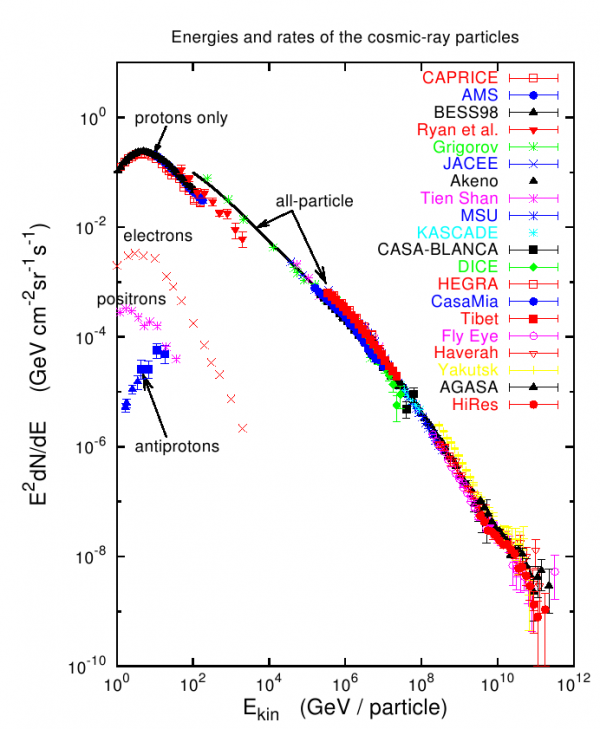
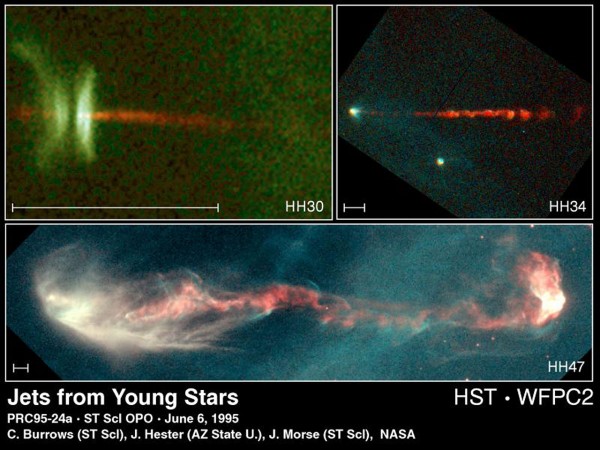
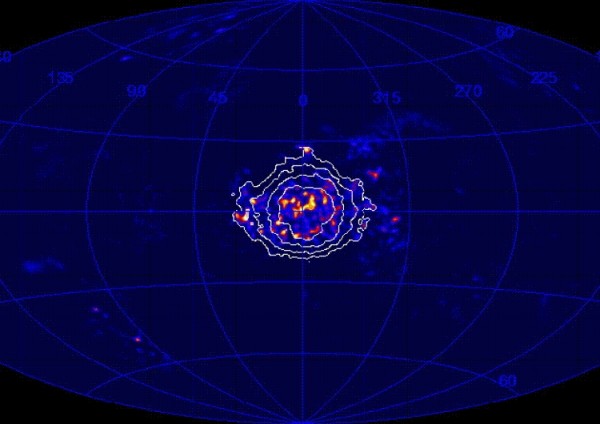




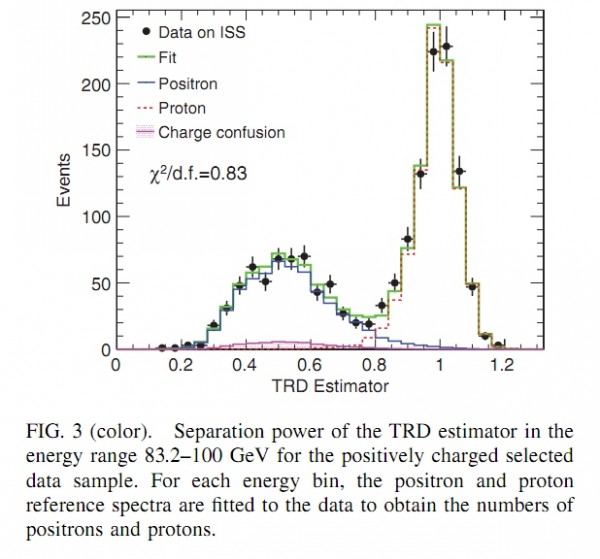
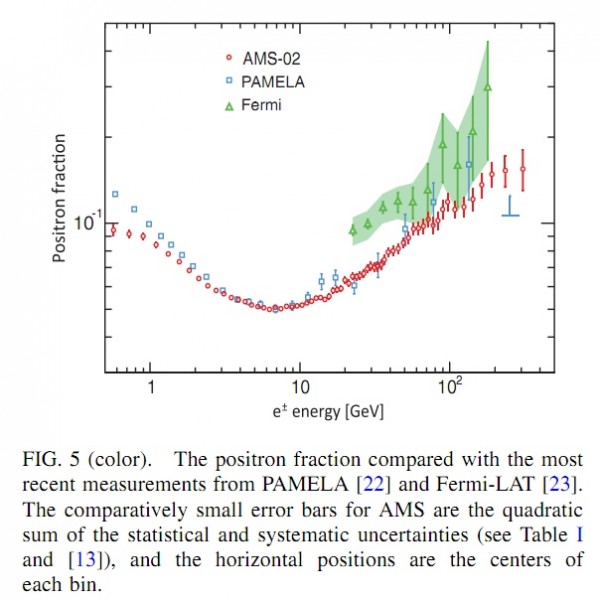

Thanks Ethan.
Yep, the hype fooled me.
And AMS looks to be an excellent instrument.
But...
""With time, we should be able to tell you whether... we've found dark matter; or ... (just) positrons.. from pulsars," Prof Ting explained. "At the moment we do not have enough particle events." ...
""At the moment, all we can say is that the (dark matter) particles could have a mass of several hundred gigaelectronvolts, but there is much uncertainty," said Prof Battiston." http://www.bbc.co.uk/news/science-environment-22016504
Well that calls for a big pre-publication press release and announcement.
So we don't know anything yet.
That is a beginning of confirmation for the string theory and BB too:
http://gravityattraction.wordpress.com/2013/04/01/boltzmann-brain-disco…
Question: First graph, y-axis: what's sr?
As in GeV / sr x s x cm^2
Scott: sr = steradian.
"Nothing funny at all here. As you can see, this is consistent with previous results, but also shows no evidence of a sharp drop-off, which is what we’d need for dark matter evidence."
I dont understand why we should observe a sharp drop-off from dark matter. Can someone explain that please?
If its self-annihilation, I could understand it if the kinetic energy of the dark matter particles is bounded. But is it? And what if there is more than one kind of dark matter particle? Like for example neutrinos? There are three of them, all with different rest masses. What if dark matter also has 3 "flavors" with different masses each. Then we wouldn’t find a sharp drop-off at all.
Cheers,
Semmel
A question to Ethan. From his post:
Based on what we know about astrophysics, there are many things that can cause an excess of positrons: stars, pulsars, black holes, annihilating dark matter--
If Invisible Dark Matter, perhaps lurking invisibly in the Randall-Sundrum Bulk, is its own antiparticle, what mechanisms could possibly exist to enable it to “annihilate” with itself?
.
There is a large drop off and it's weirdly not discussed in the release and I know Lubos noticed it as well. Look carefully at the 200-350 GeV results.
(http://motls.blogspot.com.au/2013/04/ams-02-dark-matter-announcements.h…)
"If Invisible Dark Matter, perhaps lurking invisibly in the Randall-Sundrum Bulk, is its own antiparticle, what mechanisms could possibly exist to enable it to “annihilate” with itself?"
The mechanism could be "Dark Matter isn't its own antiparticle".
I am seriously amazed by people who use the word "If" and appear to have no idea what it means.
"Finally, a dark matter signature would also be anisotropically concentrated towards the direction of the galactic center, and would very likely show a preferred directionality towards other large galaxies in the sky, such as M87. No evidence for directionality exists in the AMS data. The AMS data shows unprecedented precision in the measurement of the antimatter cosmic ray energy spectrum, and there’s plenty to be learned from this."
Every other source/blog I've read on this issue has stated exactly the opposite: dark matter would be expected to be diffuse enough to produce a highly isotropic signal, while nearby pulsars would instead be expected to introduce anisotropy. See e.g., this snippet from http://www.symmetrymagazine.org/article/april-2013/ams-tiptoes-toward-a…
"A second way to determine the origin of the excess of positrons is to consider where they’re coming from. If positrons are hitting the detector from all directions at random, they could be coming from something as diffuse as dark matter. But if they are arriving from one preferred direction, they might be coming from a pulsar.
So far, the result leans toward the dark-matter explanation, with positrons coming from all directions. But AMS scientists will need to collect more data to say this for certain."
@ Semmel
That's a good question!
In order to stick around our galaxy doing the theoretical job it was designed to do rather than fly off into the cosmos in a uniform cloud of no help whatsoever, Dark Matter has to be going at a relatively low speed -- specifically, less than escape velocity for the galaxy (which incidentally this is why neutrinos don't work as dark matter, aside from abundance issues). For the Milky way that's 525 km/s or ~ 0.1% of the speed of light.
So the energy in DM interactions is going to be dominated by the intrinsic mass of the DM particles (mc^2 >> mv^2).
There will surely be DM particles that are going faster than this and so produce positrons at a higher energy, but those are going to necessarily be much rarer. So, we should see a sharp cut-off from the relatively high positron fraction to a much lower one.
@ LdB
Pardon me if I don't think a blogger's comparison of Ting's facial expression to Sheldon Cooper hiding a secret as proof that the unpublished data shows a drop-off above 350 GeV.
OT: Sorry, your RSS feed has been failing for several weeks. I am not sure why, but I thought I'd try alert you.
(So dig this blog!)
Donn,
Here's what we've been able to find so far, from the honchos at NatGeo:
1. The feed itself works. (http://scienceblogs.com/startswithabang/feed/)
2. Plugging the feed URL into Chrome will not display what you want. Chrome doesn't translate the RSS into a human-readable format. This isn't new.
3. If you plug your feed URL into Safari, you will see a reasonably acceptable human-readable feed.
4. I received an error when I tried to add the feed to Yahoo. This may be something we can resolve, but this points to either something wrong with Yahoo or an incompatibility issue.
So... it's being worked on, but it this is where it stands right now.
There is no dark matter. The expanding universe can be explained else-wise. There were two big bangs. The first was significantly larger than the second. Most of the mass (or pre-mass) of the first big bang escaped. Mass nearest the origin collapsed back to a new singularity and exploded again, the second big bang. We are part of that second event. No light was generated by the material of the first event for some time. The total mass of the first event was great enough for it to eventually collapse, which is what it is doing now. Our second event "universe" is being drawn out, faster and faster, by the gravity of this encroaching shell. The light from this "Outerverse" has not reached us yet, but it will, and suddenly. Then there will be a new sky, unlike anything we could have imagined. There is no dark matter.
- gearpile
"There is no dark matter. The expanding universe can be explained else-wise. "
Since this expansion isn't due to dark matter, making these two claims when put together nonsense, I rather think your abilities in determining this are completely worthless.
About the feed.
Firefox has two ways of displaying the feed:
- I a separate tab
- In a submenu of the bookmarks dropdown menu (showing only the titles of the posts). This submenu is called 'live bookmarks'.
(When viewing the feed of a site in the separate tab there is a button 'subscribe to this feed using Live Bookmarks')
For several weeks now Firefox Live Bookmarks has been giving the message 'Live Bookmarks failed to load'. On the other hand, the feed display in a separate tab is perfect, by the looks of it.
Interesting situation. It may be that there is no uniformity in how browsers parse the feed. If that is the case then perhaps it is impossible to design a feed such that it is compatible with _all_ browsers.
I'll be very interested to hear what the NatGeo web team is able to find out about this.
Update:
I just read the wikipedia article about RSS feed.
http://en.wikipedia.org/wiki/RSS
Because of the many versions of RSS it must be extremely hard for any web team to try and design an RSS feed that is compatible with all feed readers.
The 'Atom feed' format was designed in 2003. Compared to RSS the Atom feed format made a clean start. Presumably that gives more uniformity.
Previously I had never paid attention to the fact that Atom feeds are also supported:
http://scienceblogs.com/startswithabang/feed/atom/
I clicked on the 'Atom feed' button, and this time Firefox displayed the 'Live Bookmarks feed'.
Feed issue:
Ethan and others - I have indeed been using the "live bookmarks" in Firefox.
Something seems to have been fixed because I once again see a list of articles in my "Starts with a Bang" sub menu.
Yay!
So if dark matter is effected by gravity, does that mean it too is forever sucked into back-holes? Is there a way of seeing black holes growing without normal matter falling in??
ElTrey:
Yes to the first question, and not really to the second AFAIK. The way we detect a black hole "eating" is by observing the flashes of x rays and gamma rays that occur when matter spirals inward and is in the process heated to many millions of Kelvin. But that depends on the in-falling matter interacting electromagnetically. Which dark matter does not.
So that just leaves noticing the gravitational effect. Considering that the gravity waves produced by a black hole forming in a supernova are at the hairy edge of detectability -- such that it's as yet no worry that LIGO has failed to detect any -- the odds of a black hole swallowing enough dark matter at once to create a noticeable gravity wave are slim to none.
CB:
So there are no other ways of detecting infalling matter into a black hole? Could a lone start go type Ia nova by pulling in dark matter, and not by siphoning a companion star's normal matter? Can a black hole's mass not be detected by the orbits of matter around it changing as it's mass is changed by unseen infalling mass? Can the curvature of light be detected as changing as a black hole's mass is changing?
I guess what I'm getting at is, If it were possible to see black hole growth via dark matter, would that give us any information into the nature of dark matter?
There is no dark matter. There were two big bangs. The first one was gigantic and I will call it the "outer-verse". Most of it escaped into deep "space". Some of the pre-mass didn't escape and was drawn back to the origin. The compression of the collapsing pre-mass caused another smaller big bang. That smaller big bang is us. Lets call it the "inner-verse".
The outer-verse is collapsing now. It's encroaching gravity is causing the inner-verse to expand faster and faster. We can't see it yet, but someday the light of the outer-verse will finally reach us. There will be a new increasingly bright night sky.
There is no dark matter.
@gearpile #25: You may not realize it, but this is a _science_ blog, not a "random uninformed speculation" blog. Please provide appropriate, and preferably peer reviewed, citations for your unsupported and unrecognized assertions. Thanks!